The Economics and Statistics Division maintains archives of previous publications for accountability purposes, but makes no updates to keep these documents current with the latest data revisions from Statistics Canada. As a result, information in older documents may not be accurate. Please exercise caution when referring to older documents. For the latest information and historical data, please contact the individual listed to the right.
<--- Return to Archive
For additional information relating to this article, please contact:
July 08, 2024AVERAGE RETAIL PRICES, MAY 2024 Statistics Canada makes available scanner data on prices collected for a range of food and personal care items. These prices are collected through point-of-sale (transaction) data obtained directly from Canadian retailers. The data represent commonly purchased items (which do change over time), but are not representative of the Consumer Price Index weights. Over time, products are rotated and quantity or quality may change. Comparisons of prices from one time period to another may reflect quantity and quality changes as well as price changes.
For the purposes of this analysis, the 110 items reported by Statistics Canada will be grouped into:
- Meat, fish, poultry and meat substitutes
- Dairy, eggs and substitute products
- Fruit (including canned and frozen products)
- Vegetables (including canned and frozen products)
- Grains, cereals, beans, legumes and nuts
- Sugar, juices, cooking oils, condiments and prepared foods
- Health and cleaning products
Beef and salmon are the most expensive of meat and seafood products. Several meat and substitute products in Nova Scotia were more expensive than the national average in May: meatless burgers, canned tuna, bacon, chicken breasts, whole chicken, pork rib cuts, ground beef and top sirloin cuts of beef.
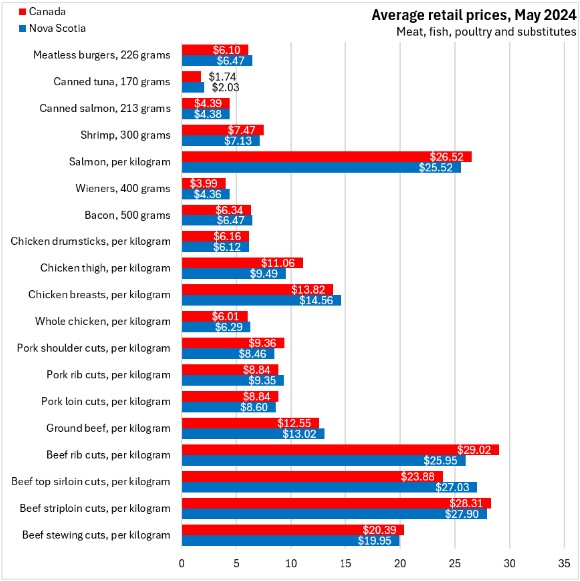
Over the last year (May 2024 vs May 2023), the consumer price index for all items in Nova Scotia excluding food increased by 3.9%. At the same time average weekly earnings across all Nova Scotia industries increased by 8.2%.
Prices for many meat, seafood and substitute products have grown faster than average weekly earnings over the last year. However, seafood, bacon, weiners, chicken drumsticks and pork loin cuts all reported lower prices in May 2024 than in May 2023.
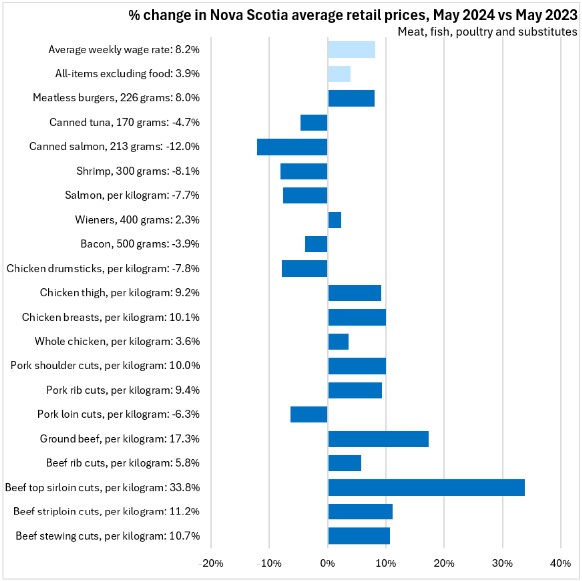
Food prices have been distorted in recent years by global market conditions following the pandemic and Russia's invasion of Ukraine. Compared with May 2019, prices for most meat products have grown faster than average weekly earnings in Nova Scotia. The exceptions were: meatless burgers, seafood, bacon, chicken drumsticks, pork (shoulder and loin cuts) and beef ribs.
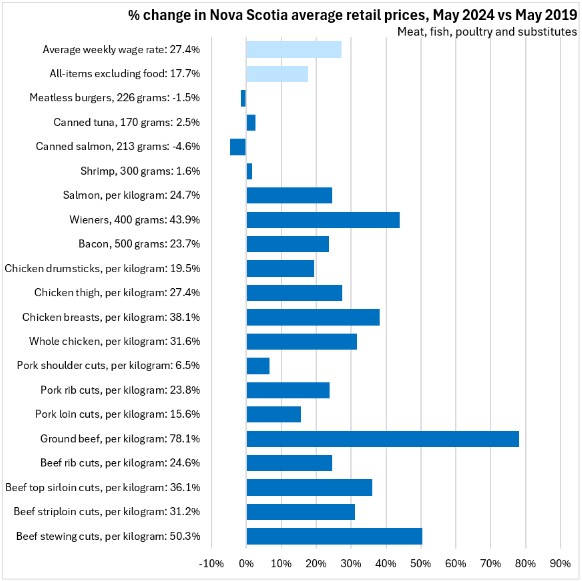
Dairy and egg prices were generally higher than the national average in Nova Scotia in May 2024 (exceptions: butter, soy milk, milk in 2 litre containers).
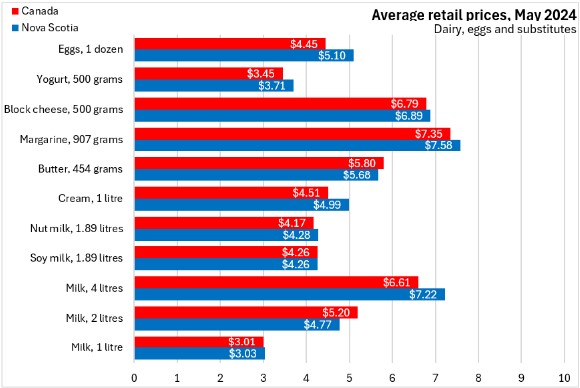
Compared with May 2023, reported dairy and egg prices have all grown more slowly than average weekly earnings. Some products have reported year-over-year declines in prices: eggs, butter, cream, nut milk, soy milk.
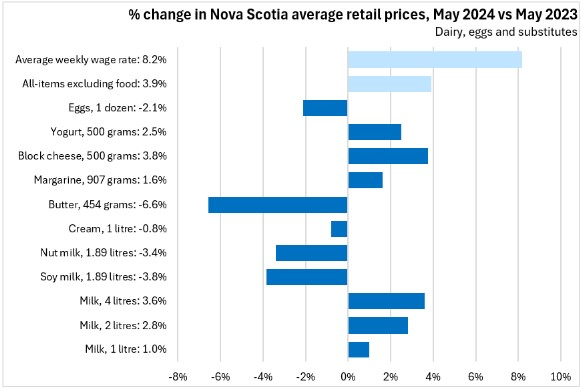
Over the last 5 years, the prices of eggs, margarine, butter and milk in 4 litre containers have all grown faster than average weekly earnings.
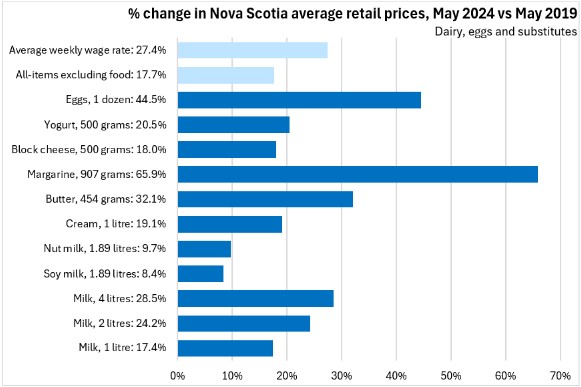
Prices for reported fruits in Nova Scotia were all higher than the national average for similar products. The largest gaps (in percentage terms) were for limes, bananas, strawberries and cantaloupes.
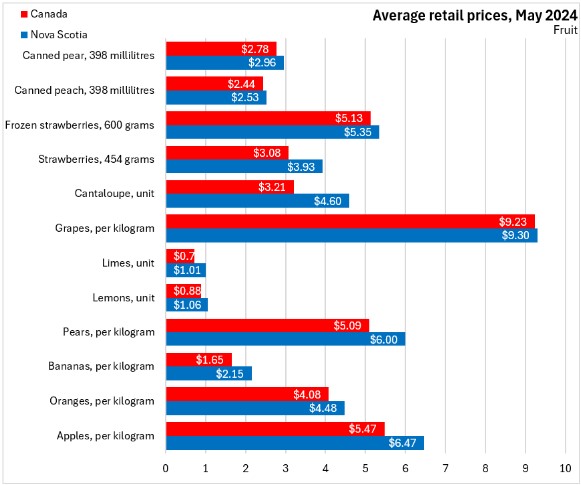
Many fruit prices have fallen in the last year and average weekly wage growth has outpaced all reported fruits.
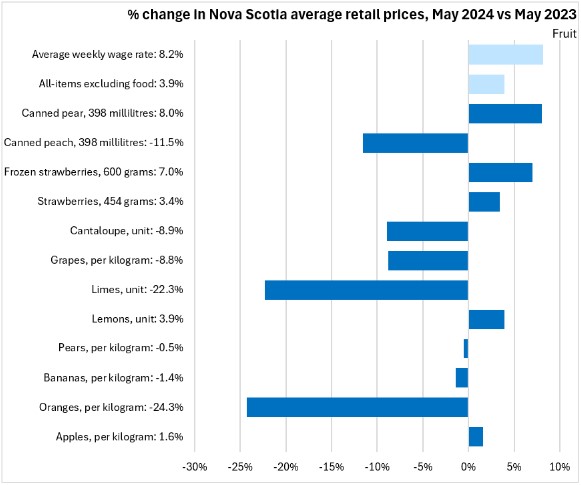
Over the last 5 years, most reported fruit prices have not grown as quickly as average weekly earnings (exceptions: cantaloupe, canned pears, grapes).
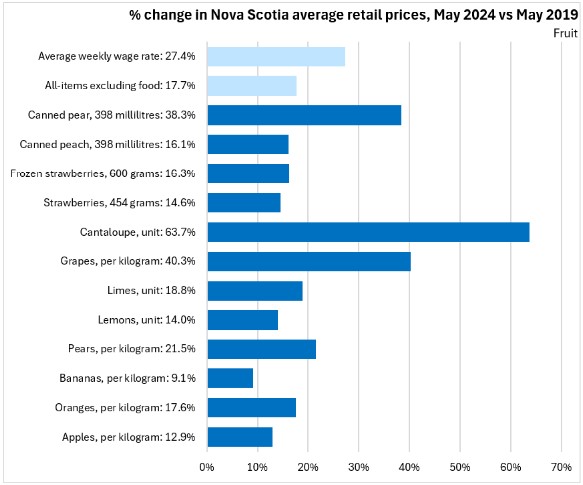
Almost all reported vegetable prices were higher in Nova Scotia than the national average in May 2024 (exceptions: salad greens, avocados). In percentage terms, the largest gap was for broccoli.
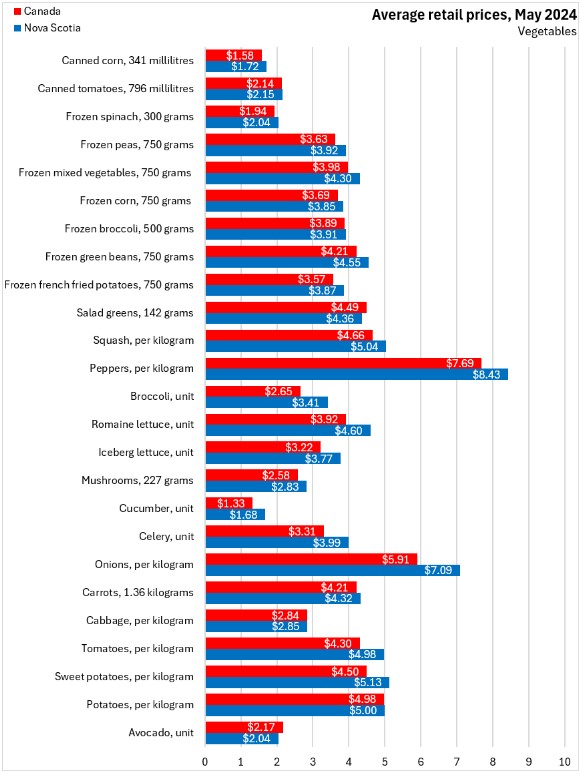
Average weekly wage growth from May 2023 to May 2024 has outpaced price increases for most reported vegetables (exceptions: canned corn, frozen french fries, romaine lettuce, onions, carrots, sweet potatoes, avocados). Several vegetable products reported lower prices over the last year, led by squash, frozen spinach and broccoli.
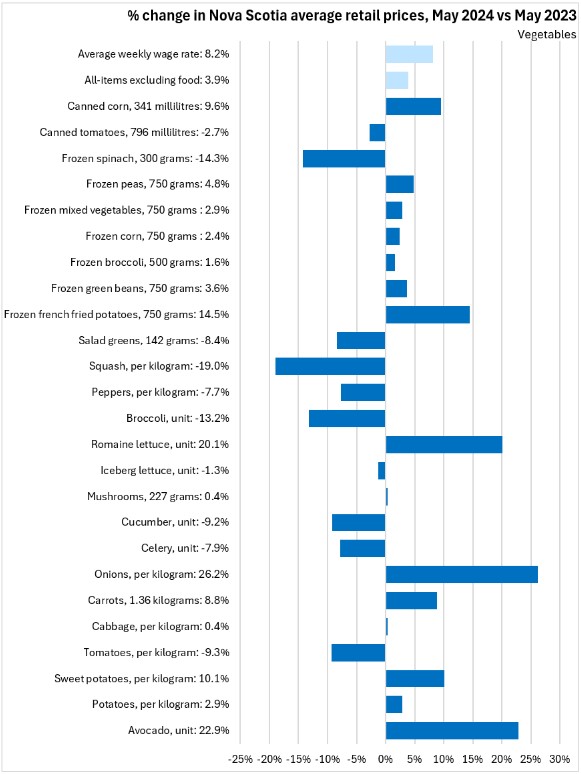
Over the last 5 years, vegetable prices have outpaced wage growth for the following products: canned corn, canned tomatoes, frozen french fries, lettuce (both romaine and iceberg), mushrooms and onions.
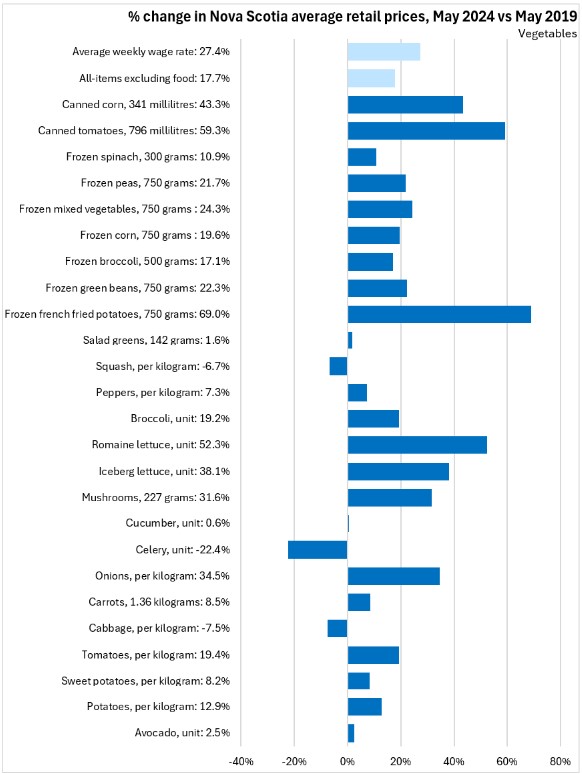
Nova Scotia prices for grain, cereal, nut, bean and legume products were higher than the national averages for all reported products except tofu.
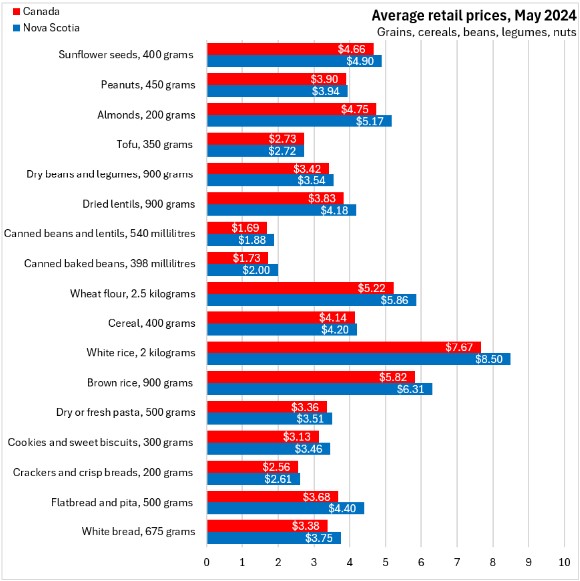
Over the last year, average weekly wages have grown faster than prices for all reported grain, cereal, nut, bean and legume products except canned baked beans. Several grain, nut, bean and cereal prices fell in Nova Scotia over the last year: sunflower seeds, almonds, dry beans/legumes, wheat flour, cereal, rice (white and brown), pasta, cookies, crackers, flatbreads and white bread.
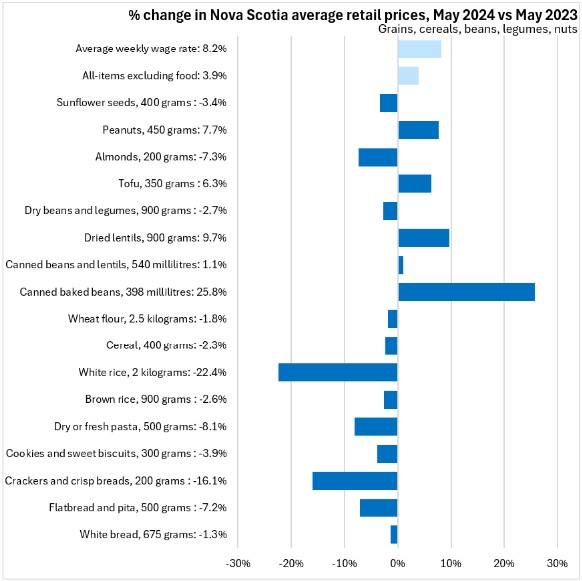
Over the last 5 years, prices for many reported grain, cereal, bean, legume and nut products have outpaced growth in average weekly earnings (excptions: sunflower seeds, peanuts, almonds, dry beans/legumes, canned beans/lentils, wheat flour, white rice, cookies and crackers.
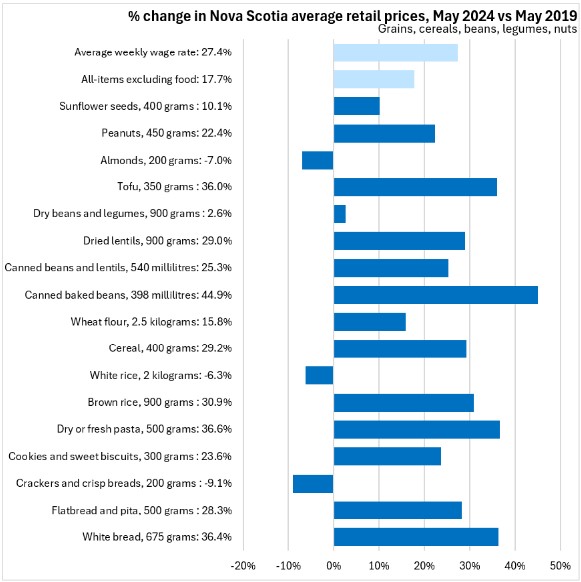
Among prepared foods, condiments, cooking oils, fruit juices and sugar as reported by Statistics Canada, only pasta sauces and salsa were less expensive in Nova Scotia than the national averages in May 2024.
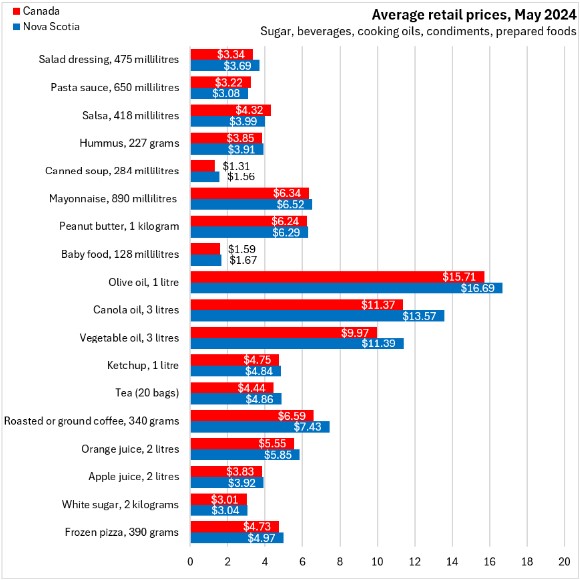
Prices for olive oil have risen sharply in the last year, well outpacing growth in average weekly earnings. Price growth also outstripped wage gains for frozen pizza, white sugar and orange juice. There were notable year-over-year declines in prices for salsa, canned soup, baby food, canola oil, vegetable oil, coffee and apple juice.
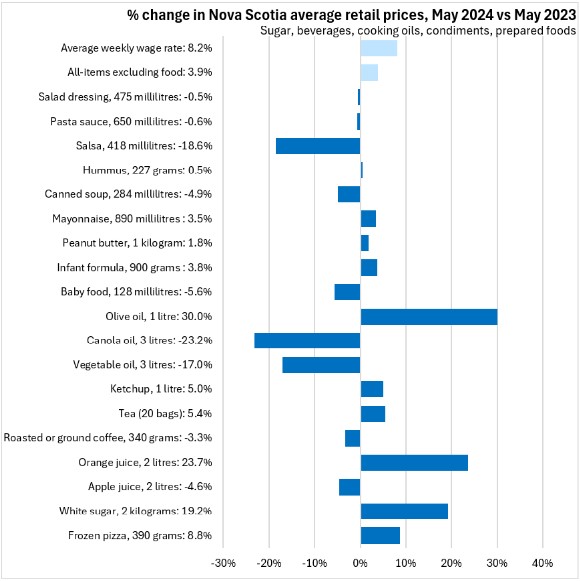
Over the last 5 years, prices for most reported foods in this category grew faster than average weekly earnings (exceptions: salsa, hummus, baby food, coffee, apple juice, frozen pizza).
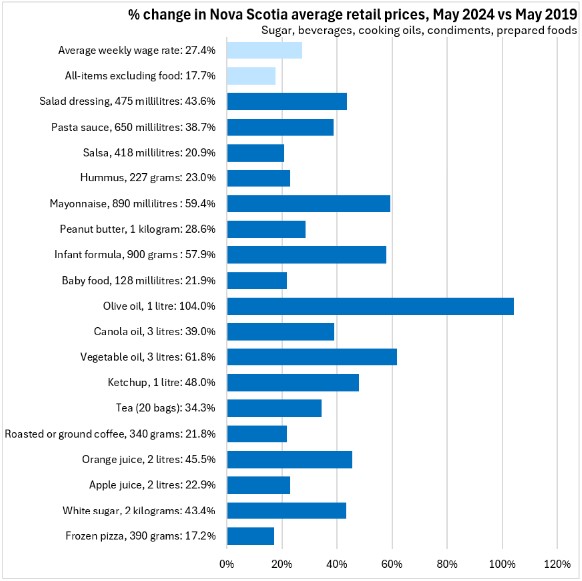
Of all products reported by Statistics Canada, infant formula (900 grams) has the highest transaction price based on the volume chosen. Nova Scotia infant formula prices were lower than the national average in May 2024.
Prices for health products (shampoo, toothpaste, deodorant) were higher in Nova Scotia than the national average, though the price of laundry detergent was lower.
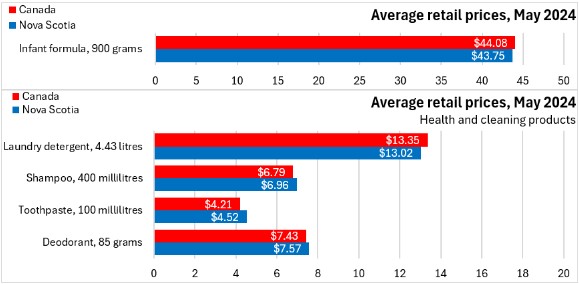
Over the last year, prices for health and cleaning products did not grow as fast as average weekly wages. Laundry detergent prices were down substantially in Nova Scotia.
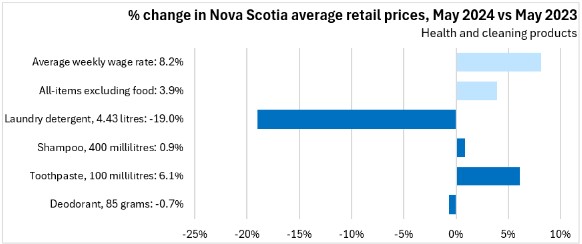
Over the last 5 years, all reported health product prices grew faster than average weekly earnings in Nova Scotia. However, the price of laundry detergent grew more slowly than Nova Scotia average weekly earnings.
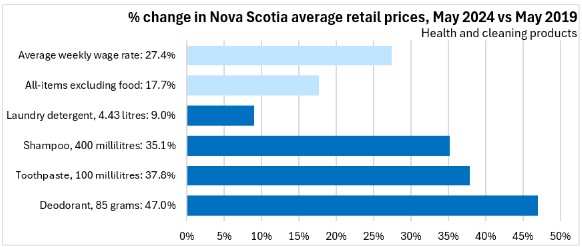
Source: Statistics Canada. Table 18-10-0245-01 Monthly average retail prices for selected products; Table 18-10-0004-01 Consumer Price Index, monthly, not seasonally adjusted; Table 14-10-0063-01 Employee wages by industry, monthly, unadjusted for seasonality
<--- Return to Archive